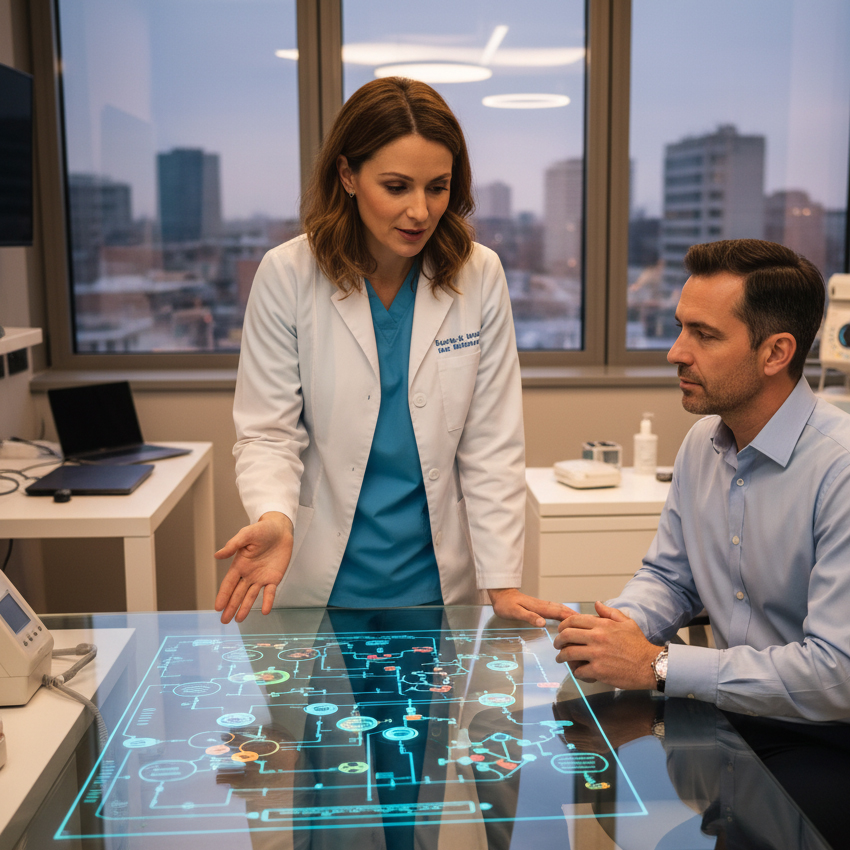Solving Challenges in
Legacy Clinical Care and Research
Legacy clinical care is optimised for safety, triage, and guideline-driven prescribing. It is reliable at ruling out emergencies and managing common conditions, yet it is poorly configured for answering questions that require granular views of cellular and host metabolism.
The result is a widening gap between what biology demands for causal inference and what clinics and studies routinely measure.
At the point of care, most workflows stop at basic serum chemistry, some RBC + WBC metrics, limited metabolic panels and speculative markers of interest.
Intracellular cofactors, minerals, and metalloproteins, which determine whether enzymes can function at all, are rarely assayed. Training reinforces this bias: clinicians are taught to select or adjust drugs, not to interrogate enzyme-level constraints or cofactor sufficiency as first-class diagnostic variables. When minerals are tested, they’re normally tested in serum and treated as static concentrations rather than dynamic requirements of metallo-enzymes that govern flux through pathways.
Without assays that resolve what is happening inside cells and compartments, the clinician sees symptoms and downstream markers, not the constraints that produce them.
Tooling mirrors the curriculum. There are few practical diagnostics that quantify systems and cellular performance at a resolution that supports causal reasoning. Data arrive as single numbers against wide reference ranges, not as integrated depictions of pathway capacity, bottlenecks, or compensation. Specialisation compounds the problem. Rheumatology, neurology, gastroenterology and others each own a slice of the phenotype, but the shared metabolic ground, eg. ATP economy, redox balance, ion handling, cofactor availability and proteostasis sits between silos.
In Information Technology there is a systems administrator role, who maintains cross-cutting function; medicine lacks an equivalent role with the mandate and tools to maintain metabolic integrity across tissues. The practical effect is predictable and care plans currently attempt to “patch” pathways downstream rather than remove upstream constraints.
These clinical limitations carry directly into research. Many trials and observational studies are designed and interpreted without the ionomic, coenzyme, and metalloproteome context that determines whether an intervention can work. A drug targeting an enzyme cannot be fully evaluated if its required cofactor is variably deficient in the cohort.
Likewise, genome-wide association signals are frequently interpreted without conditioning on cofactor status or metal homeostasis, which can modulate phenotype expression and obscure genotype-phenotype links. Studies are often executed within a single layer of the biological stack-genome, transcript, protein, metabolite, or clinical outcome-then conclusions are drawn as if upstream and downstream layers were stable. In engineering terms, this is testing a subsystem without instrumenting the dependencies that bound its performance.
Measuring outcomes in one tissue or pathway while ignoring systemic context introduces avoidable confounding. Effects that are contingent on eg. redox state, magnesium, phosphate or zinc availability, TPP, NAD+, NADPH, CoA, P5P or FAD supply, or mitochondrial load will average toward null, inflate variance, or produce irreproducible subgroup effects. Negative or modest findings then propagate into guidelines, cementing therapeutic nihilism where the intervention was never biochemically enabled in the first place. Conversely, apparent positives can reflect short-term compensation in one layer while costs accrue in another, which go unmeasured.
The consequences are practical, where patients cycle through symptomatic algorithms while root-cause constraints persist. Trials under-detect effect sizes that would emerge within biochemically competent strata. Health systems pay for repeats, escalations, and polypharmacy that a causal audit might have prevented.
None of this implies malfeasance; it reflects a systemic tooling and training gap between twentieth-century clinical operations and twenty-first-century biology.
A better model is conceptually simple, though operationally demanding. Point-of-care needs assays that resolve intracellular and compartment-specific status of key cofactors, minerals, and enzyme activities, with readouts mapped to pathway capacity rather than isolated concentrations.
Clinicians need systems that interpret multi-layer data which infers bottlenecks and then tests causality with targeted challenges. This allows root-cause remediation, rather than a patient care model that issues guidance on “metabolic patches” as drug prescriptions, often based on rudimentry markers and observational data.
Research also needs protocols that condition randomisation, analysis, and interpretation on cofactor sufficiency and ionome/metalloproteome context, along with multi-layer sampling that comprehensively spans host and microbiome genome to metabolome and clinical phenotype on the same individuals and timelines. When studies cannot feasibly measure every layer, they should declare assumptions about unmeasured layers and test their influence in sensitivity analyses.
If legacy care excels at managing risk under uncertainty, the next phase must excel at reducing uncertainty. That requires building a clinical “systems administration” function that owns cross-layer metabolic integrity, retraining practitioners to think like biological engineers, and developing diagnostics that make pathway-level performance visible at routine point-of-care.
With these pieces in place, both care and research can move from patching symptoms to removing constraints, from correlation to causation, and from averages to physiology.
Many of the tools and labs required to perform these types of diagnostics already exist in some form that is available to clinicians, however the data they provide often requires further translation before an actionable care plan can be created. As such, there is an opportunity to enhance clinical outcomes, today, with the right software automation, disease modelling and clinical education services.

Connect with me
For consulting, engagements and all
other enquiries, please use this link:
